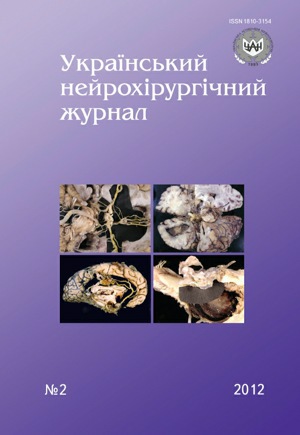Observation of successful treatment of penetrating traumatic brain injury followed by nasal liquorrhea for 61 years
DOI:
https://doi.org/10.25305/unj.59052Keywords:
penetrating traumatic brain injury, nasal liquorrhea, CT-cisternography, meningoceleAbstract
An observation of penetrating traumatic brain injury, made by awl in childhood, followed by remittent nasal liquorrhea and purulent meningoencephalitis for 61 years, is given.
For diagnosis clarifying biochemical study of nasal secretion, rhinologic study, MRI and CT-cisternography of the brain were performed. Liquor fistula was closed in two stages, ethmoid bone meningocele, causing obturation of left half of the nose, was removed.
On the first stage, using transnasal approach, ethmoid bone meningocele was removed, on the next stage liquor fistula was discharged, using transcranial intradural approach. Anterior cranial fossa base defect was closed with temporal muscle fragment and fixed with fibrin-thrombin glue.
References
1. AArabi B, Alden TD, Chesnut RM, et al. Management and prognosis of penetrating brain injury. J Trauma. 2001;51 (Suppl):1–86.
2. Knuth T, Letarte PB, Ling G, et al. Guidelines for field management of combat-related head trauma. New York: Brain Trauma Foundation; 2005.
3. Borovich B, Braun J, Yosefovich T, Guilburd J, Grushkiewicz J, Peyser E. Intracranial Penetration of Nasogastric Tube. Neurosurgery. 1981;8(2):245-247. [CrossRef] [PubMed]
4. Yamamoto I, Yamada S, Sato O. Unusual craniocerebral penetrating injury by a chopstick. Surgical Neurology. 1985;23(4):396-398. [CrossRef] [PubMed]
5. Youngshu C, Guojun Z. Transorbitocranial injuries caused by chopstick and glass splinters. Chin Med J. 1980;93(7):487–490.
6. Bursick D, Selker R. Intracranial pencil injuries. Surgical Neurology. 1981;16(6):427-431. [CrossRef] [PubMed]
7. Ossoff R, Elonka D, Sisson G, Bytell D. Steel Bar Penetrating the Skull. Otolaryngology -- Head and Neck Surgery. 1982;90(5):567-568. [CrossRef] [PubMed]
8. Tiwari SM, Singh RG, Dharker SR. Unusual craniocerebral injury by a key. Surg Neurol. 1978;9(9):267.
9. Potapov A, Likhterman L, Zelman B, Kornienko V, Kravchuk A. [Evidence
Downloads
Published
How to Cite
Issue
Section
License
Copyright (c) 2012 Lyudmila Dzyak, Andriy Sirko, Ihor Kirpa, E. Sapronova, Ekaterina Mizyakina

This work is licensed under a Creative Commons Attribution 4.0 International License.
Ukrainian Neurosurgical Journal abides by the CREATIVE COMMONS copyright rights and permissions for open access journals.
Authors, who are published in this Journal, agree to the following conditions:
1. The authors reserve the right to authorship of the work and pass the first publication right of this work to the Journal under the terms of Creative Commons Attribution License, which allows others to freely distribute the published research with the obligatory reference to the authors of the original work and the first publication of the work in this Journal.
2. The authors have the right to conclude separate supplement agreements that relate to non-exclusive work distribution in the form of which it has been published by the Journal (for example, to upload the work to the online storage of the Journal or publish it as part of a monograph), provided that the reference to the first publication of the work in this Journal is included.









